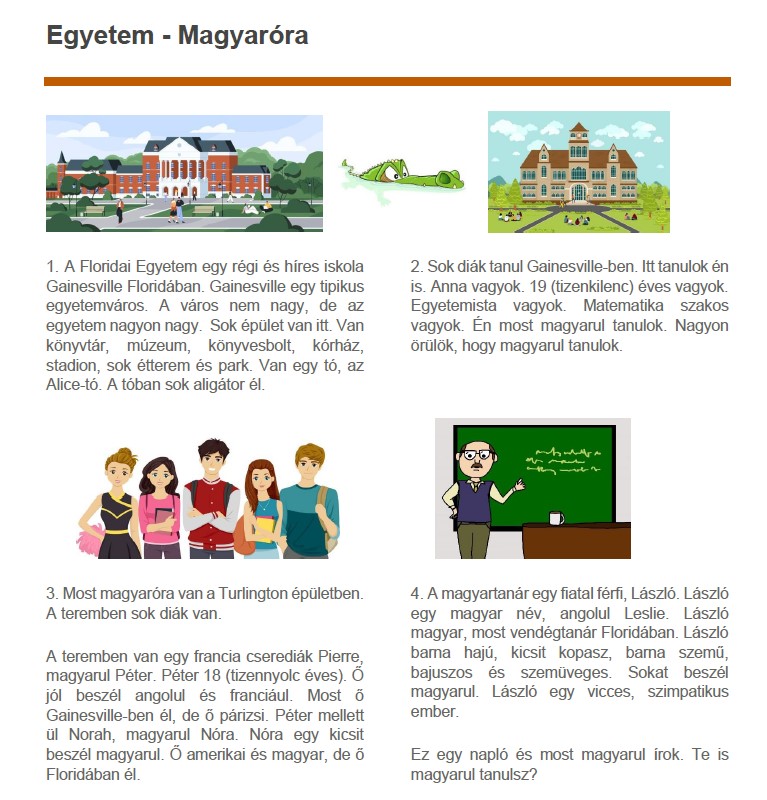Chapter 1 – Part 1 – Egyetem-Magyaróra

Pronunciation warm up
1. According to the length of pronunciation the vowels can be classified as short (a,e,i,o,ö,ü) or long (á,é,í,ó,ő,ű) vowels.
2. According to the position of the tongue, whether the front or the back part of the tongue is raised against the gum, the vowel can be classified as the front (e,é,i,í,ö,ő,ü,ű) or back (a,á,o,ó,u,ú) vowels.
Vowels – all
What do you hear?
a or á?
Vocabulary – Practice the pronunciation of the following words
Focus on the vowels.
Keep in mind: stress is always placed on the first syllable of a word.
Reading text

Listening
audio/video – TBA
Dictation
Egyetem-Magyaróra
Reading – Read the text and learn the new vocabulary
A Floridai Egyetem egy régi és híres iskola Gainesville Floridában. Gainesville egy tipikus egyetemváros. A város nem nagy, de az egyetem nagyon nagy. Sok épület van itt. Van könyvtár, múzeum, könyvesbolt, kórház, stadion, sok étterem és park. Van egy tó, az Alice-tó. A tóban sok aligátor él.
Sok diák tanul Gainesville-ben. Én is itt tanulok. Anna vagyok. 19 (tizenkilenc) éves vagyok. Egyetemista vagyok. Matematika szakos vagyok. Én most magyarul tanulok. Nagyon örülök, hogy magyarul tanulok.
Most magyaróra van a Turlington épületben. A teremben sok diák van.
A teremben van egy francia cserediák Pierre, magyarul Péter. Péter 18 (tizennyolc éves). Ő jól beszél angolul és franciául. Most ő Gainesville-ben él, de ő párizsi. Péter mellett ül Norah, magyarul Nóra. Nóra egy kicsit beszél magyarul. Ő amerikai és magyar, de ő Floridában él.
A magyartanár egy fiatal férfi, László. László egy magyar név, angolul Leslie. László magyar, most vendégtanár Floridában. László barna hajú, kicsit kopasz, barna szemű, bajuszos és szemüveges. Sokat beszél magyarul. László egy vicces, szimpatikus ember.
Practice exercises
1. Find the nouns (without endings)
2. Missing words – paragraph 1
3. Missing words – paragraph 2
4. Which one should I use?
BASICS – TYPE OF WORDS/PARTS OF SPEECH
- Verbs (Igék) - Nouns (Főnevek) - Numeral (Számnév) - Adjectives (Melléknevek) - Adverb (Határozószó) - Igenév (Participle) - Pronouns (Névmások)
1. HUNGARIAN ARTICLES, DEMONSTRATIVE PRONOUNS
1. Indefinite article: egy [a, an] – is used less frequently than in English, because if the person or object is indicated only in a general sense then no article is used. Also, the same word is used for the cardinal number 1 – egy [one].
2. Definite article: a, az [the] – is used before a noun to show that the thing denoted by the noun is marked as a definite thing distict from all other things or it has already been mentioned previously.
3. Demonstrative pronouns: ez, az [this, that] – the form of the definite article az used before words beginning with a vowel is identical to the demonstrative az. The demonstrative pronoun is always stressed and separated from the noun by a pause.
For example:
| Az iskola. | The school. |
| Az az iskola. | That school. |
2. USE OF “IS” [also, too]
The word “is” [also] is always placed after the word for which it qualifies. It is never stressed and is pronounced together with the preceding word as if it were a suffix.
For example:
| Itt tanulok én is. | I also study here. |
3. “VAN” MEANINGS
1. being verb – 3rd person singular (van)
| én | vagyok |
| te | vagy |
| ő | invisible with noun and adjective (van is only used if it refers a place or a time) |
For example:
| Én egyetemista vagyok. | I am a college student. |
| Te egyetemista vagy. | You are a college student. |
| Ő egyetemista. | (S)he is a college student. |
| Ő teremben van. | (S)he is in a classroom. |
2. there is (van) – ‘exist(s)’ – existential constructions use the verb van
For example:
| A teremben van egy francia cserediák. | There is a French exchange student in the classroom. |
| *Egy francia cserediák van a teremben. | A French exchange student is in the classroom. |
| *A francia cserediák a teremben van. | The French exchange student is in the classroom. |
4. “SOK” OR “SOKAT”
The adverb “sok” [many, a lot] is used with a noun, and the accusative form “sokat” is used with a verb.
For example:
| A teremben sok diák van. | There are many students in the room. |
| Sokat beszél magyarul. | (S)he speaks a lot of Hungarian. |
Did you know? – Culture Corner
Hungarian names – Magyar nevek
Hungarian is one of the few languages in Europe to use the “Eastern name order”: family name followed by given name. Some people have more than one given name, but only one is normally used.
Hungarian is a grammatically gender-neutral language (it has no gender pronoun), but unisex given names don’t exist in practice (except “Gabi” the nickname of Gábor(m)/Gabriella(f) names).
Given names/nicknames are sometimes confused the non-native speakers. Test yourself on Hungarian given names.
Is it a male or a female name?
Hungarian education – Higher Education
university
hungarian class
old
and
famous
school
in Florida
typical
college town
town, city
big, large
very
many, a lot
building
here
library
museum
bookstore
hospital
stadium
restaurant
park
lake
in the lake
alligator
(s)he lives
student
(s)he learns, studies
in Gainesville
I
too, also
I study
nineteen
year-old
college student
math major
now
in Hungarian
I am glad
that
in a building
in a classroom
French
exchange student
eighteen
(s)he
well
(s)he speaks
in English
in French
but
Parisian
next to
(s)he sits
a little
American
Hungarian language teacher
young
man
name
visiting professor
brown haired
bald
brown eyed
a person with a moustache
a person with glasses
lot
funny
likeable
person, man
this
diary
I write
you
you learn/study
